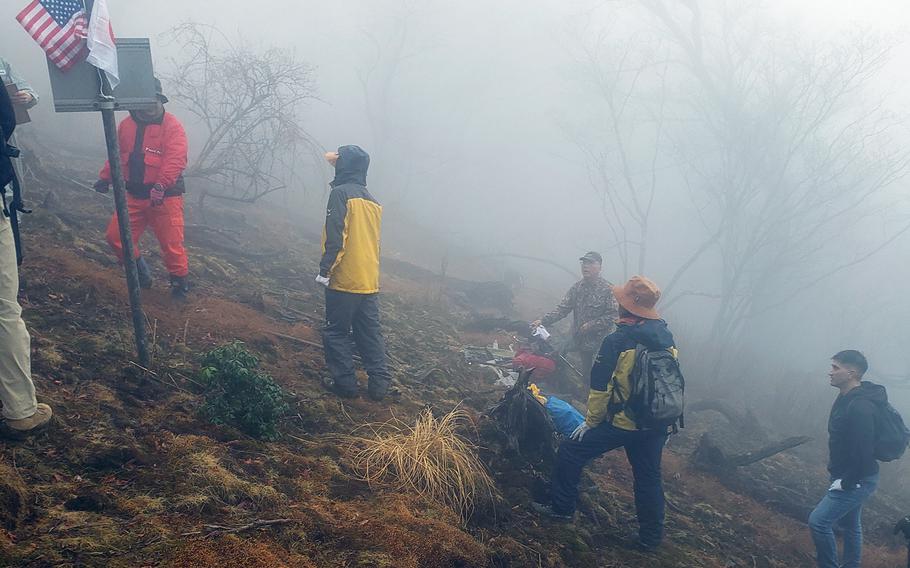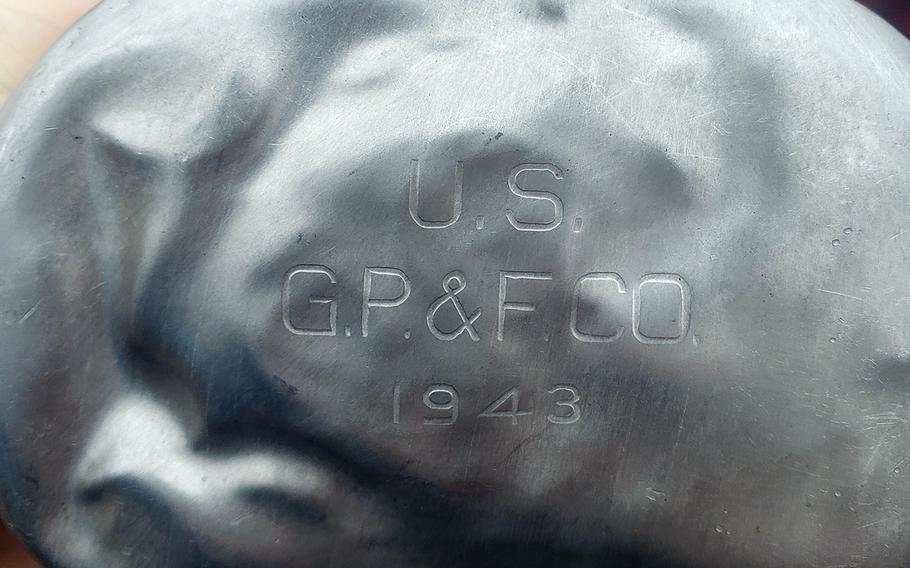Asia-Pacific
US, Japanese team honors WWII airmen before recovering parts of their crashed B-29 bomber
Stars and Stripes April 5, 2023

A group of U.S. military officers partnered with Japanese hikers in southeastern Japan, March 26, 2023, to recover parts of a B-29 Superfortress that crashed in the waning days of World War II. (Joshua Geiger)
A group of U.S. military officers partnered with Japanese hikers in southeastern Japan last week to recover parts of a B-29 Superfortress that crashed in the waning days of World War II.
Three Americans, a translator and eight local residents scaled Mount Oyaji in the heart of Kyushu, the southernmost of Japan’s four main islands, on March 26 to pay homage to 12 U.S. airmen who perished on Aug. 30, 1945, Army Maj. Joshua Geiger told Stars and Stripes by phone Tuesday.
The team, including Geiger, held a memorial service at the site before recovering engine parts, ammunition and a canteen, he said. The items will be used to educate local school children about the war.
“It’s pretty incredible,” Geiger said from the Japan Self-Defense Force’s Western Army headquarters in central Kyushu, where he serves as a liaison. “This is not the type of thing a whole lot of contemporary service members get to do.”

This canteen was found March 26, 2023, atop Japan's Mount Oyaji where a B-29 Superfortress bomber crashed in the waning days of World War II. (Joshua Geiger)
The B-29, known as the “Riggs Crew” after its commander, 1st Lt. Jack Riggs, was lost in a fiery crash three days before Japan’s official surrender.
The bomber was ferrying supplies from Tinian to a prisoner-of-war camp in Fukuoka prefecture when it struck a ridge.
The recovery mission began taking shape about a year ago when a civic group in town contacted Geiger’s predecessor to see if any service members might participate in a ceremony honoring the crew, Geiger said. The group was restarting annual memorial services at a monument near the base of the mountain after a layoff for the COVID-19 pandemic. It also asked if the service members wanted to visit the crash site with their members who maintain it.
Geiger, of Norfolk, Va., enlisted fellow liaison Capt. Bradley Hood and Capt. Kurt James, a pair of Marines also working at the base.
The hikers’ unofficial leader, Hiroshi Kudo, discovered Riggs Crew debris in 1987 while researching bears on Oyaji, he told Stars and Stripes by phone Tuesday. The discovery spurred Kudo to seek more information about the wreck and push for the monument, which was erected in 1995.
Kudo and his friends also placed signboards with photos and information about the crew at the impact site, he said.
“They won the war, and those soldiers were supposed to go back to their nation alive but didn’t,” Kudo said. “It is necessary to pray for them every year and to let people know about them.”
For the March 26 memorial service, the team started up the mountain at around 9 a.m., ensconced in a thick fog, Kudo said. A light rain fell most of the day.
The hikers reached the 5,400-foot summit after about 90 minutes, Kudo said. They recovered a 175-pound piece of the bomber’s engine that he found with a metal detector last summer.
They also uncovered .50 caliber machine-gun ammunition and an intact canteen, Geiger said.
The hunk of engine was affixed to bamboo poles with wire and carried down the mountain in rotating teams of four, Kudo said. It will be kept at the Takachiho Community Center and used to educate the town’s youth about the war.
The 46-ton aircraft was on fire instantly after striking the ridge on neighboring Mount Shoji in dense fog, Kudo wrote on the community center’s website. The aircraft slid for about 1,000 feet before stopping on the northwest side of Oyaji, where it exploded, killing all 12 on board.
The men were buried at the site by locals immediately after the crash, Geiger said. Their remains were repatriated shortly thereafter by an Army graves registration unit.
Connecting with the Riggs Crew had an immense impact on Geiger, a combat veteran of Iraq and Afghanistan, and his Marine counterparts, he said.
“It was pretty striking that this bomber crew made it through the war and were killed doing relief work,” he said. “We were there to show our appreciation to [Kudo’s] group for their dedication in maintaining these sites all these years.”